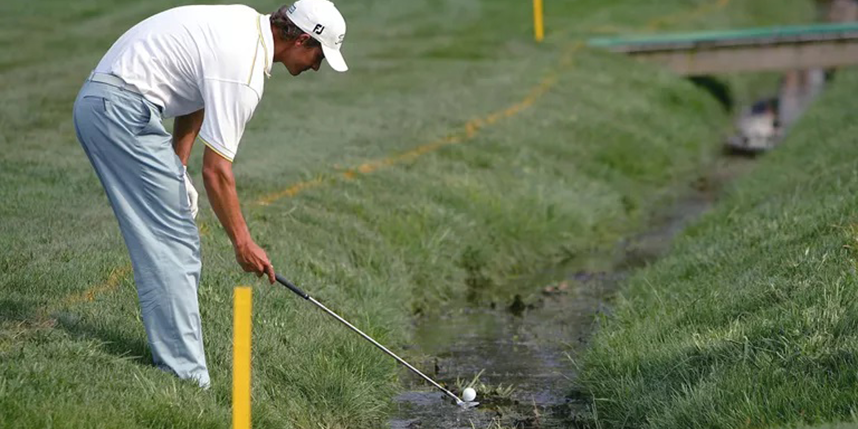
Penalty Areas: How to remember the difference between Yellow and Red
By Suzanne Olsen
Some Penalty Areas (PA) are marked red in spots, and yellow in others, so what to do?
The most important thing to determine is the spot where your ball last crossed the edge of the PA. The edge of a PA extends up and down. This is your reference point for taking relief with a one-stroke penalty.
Bear in mind that you may hit out of a PA without a penalty. Not all PAs have water in them after all. Even if you decide to hit out of a PA and fail to get it out, or hit it OB, or into an unplayable lie outside of the PA, you may still proceed under the PA Rule (Rule 17.1d), using the spot where the ball last crossed the edge of the PA as the reference point for taking relief – taking the penalty stroke for OB or unplayable, plus the penalty for PA relief.
Let’s review the options that cost a golfer a one-stroke penalty:
- Yellow-2 Options
- Hit from where you originally hit the ball (stroke and distance)
- Keep the point where the ball last crossed the edge of the PA between you and the flagstick. Choose a reference point on that line, as far back as you like. Drop the ball within one club length of the reference point not nearer the hole than the reference point.
- Red-3 Options
1 & 2 are the same as for Yellow.
- Drop a ball within two club lengths of the point where the ball last crossed the edge of the PA, no closer to the hole. You may use any club in your bag to measure, other than a putter.
Note: As with many Rules providing relief options, not all options are always available given the situation.
The concept of where the ball last crossed the edge of the PA seems to be as confusing as the difference between Yellow and Red. You must accurately identify it though, so you can properly take relief.
For example, a ball may cross the edge on the tee side of a body of water, sail over the water towards a green, hit a tree on the other side that is 20 feet from the PA, and bounce back into the water. Where did the ball last cross the edge? On the green side. If the ball had somehow hit something on the ground on the green side outside of water but within the edge of the penalty line, and then bounced backward into the water, where is the last place it crossed the edge? On the tee side.
Your reference point for taking relief will be different in these two cases, and your options for relief will be dictated by the color of the PA where the ball last crossed. It’s possible (although unlikely) that a ball could bounce around and cross the edge of a PA several times. Only where it LAST crossed is relevant!
And finally, some PAs are marked with a red and yellow stake right next to each other…..huh??!! Let’s say the left one is yellow and the right one is red. Part of the PA is treated as yellow and part of it is treated as red. (Course designers intend for you to have to hit over a PA as part of the challenge of the course, so they mark it yellow.) So if your ball crosses the edge of the PA to the left, you have the two “yellow” options, and if to the right, the three red options.
Suzanne Olsen is an NCGA Certified Rules Official.